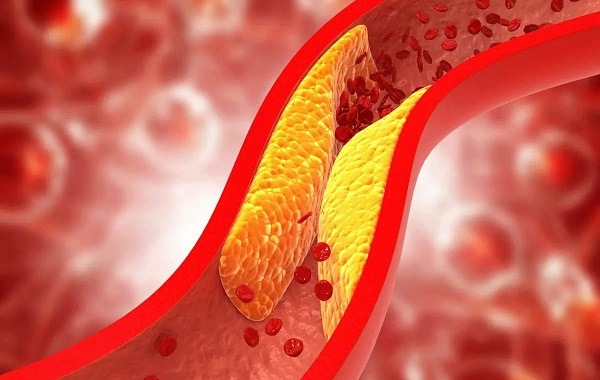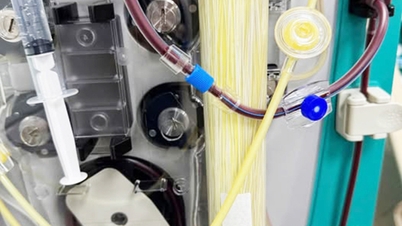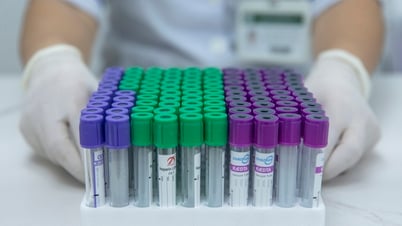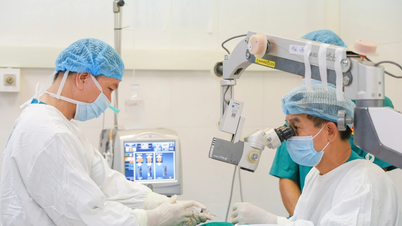In Vietnam, 5 out of 10 adults have high blood cholesterol, of which up to 70% of women aged 50-69 have this problem.
Unscientific eating, smoking, alcohol abuse, etc. cause increased cholesterol in the blood, easily leading to atherosclerosis. This is a silent cause that can cause life-threatening cardiovascular complications such as stroke.
 |
| In Vietnam, 5 out of 10 adults have high blood cholesterol. 70% of women aged 50-69 have this problem. |
According to medical experts, high blood cholesterol over a long period of time and not treated is the cause of atherosclerotic plaque formation leading to many dangerous cardiovascular diseases such as carotid artery disease, coronary artery disease, lower limb artery disease, myocardial infarction, stroke...
Although high blood cholesterol causes many dangerous complications, not all cholesterol is bad. Blood fat (lipid) is a waxy fat, consisting of two main components, cholesterol and triglyceride, which play a role in providing energy for cells and functional activities of the body.
In the blood, blood fat exists in the form of Lipoproteins, including the main types of LDL cholesterol - low molecular weight cholesterol, HDL Cholesterol - high molecular weight cholesterol and Triglyceride (neutral fat).
If LDL cholesterol is considered “bad” cholesterol, causing plaque formation in the blood vessels, HDL cholesterol is known as “good” cholesterol because it carries cholesterol back to the liver to be eliminated from the body.
Dyslipidemia (or lipid disorder) is a condition in which the concentration of fat in the blood is too high or too low, including: Increased concentration of low-density lipoprotein (LDL-C), decreased concentration of high-density lipoprotein (HDL-C), increased concentration of Triglyceride (contained in other "bad" Cholesterol such as VLDL-C).
According to medical research, lipid disorders promote the process of atherosclerosis. The accumulation of atherosclerotic plaques causes narrowing of the lumen of the blood vessels, which can progress to severe narrowing and blockage of blood vessels leading to cardiovascular problems, the most serious of which are heart attack and stroke.
According to Associate Professor, Dr. Nguyen Thi Bach Yen, Head of Cardiology Department, Tam Anh General Hospital, Hanoi, there are many causes of dyslipidemia such as consuming too many calories, saturated fat (found in animal meat) and trans fat; regularly using alcoholic beverages; smoking and tobacco products;
Use of highly active drugs such as thiazides, retinoids, cyclosporine, tacrolimus, estrogen and progestin and glucocorticoids…; chronic kidney disease, diabetes, hypothyroidism, primary biliary cirrhosis, other cholestatic liver diseases; polycystic ovary syndrome (PCOS), Cushing's syndrome, irritable bowel syndrome (IBS); HIV infection and nephrotic syndrome.
Associate Professor Yen said that the causes stem from habits and lifestyles such as lack of exercise; unhealthy diet, consuming a lot of fast food, processed food, fatty foods, etc.; polluted environment, stressful life, etc. are factors that cause the rate of dyslipidemia to increase, especially the age of the disease tends to be younger.
People with dyslipidemia often have no symptoms and are only detected during routine blood tests, while dyslipidemia has already silently affected the blood vessels.
Symptoms only occur when atherosclerotic plaques form, causing significant narrowing of blood vessels and affecting the function of body organs such as the heart, brain, kidneys, etc.
At this time, possible signs include: chest pain; pain when breathing heavily; pain, tension in the neck, jaw, shoulders, back; rapid heartbeat; fainting.
Some people with high cholesterol and triglyceride levels develop xanthomas, which appear as raised, yellow bumps around the eyes, elbows, and ankles. This is more common in patients with a family history of dyslipidemia.
According to Associate Professor Yen, internal medicine treatments such as using drugs combined with a balanced diet and regular exercise can effectively reduce high blood fat, stabilize blood pressure, and prevent atherosclerosis from progressing.
In cases of atherosclerosis causing narrowing of blood vessels, endovascular intervention or surgery is required to restore blood flow, prevent complications and endanger life.
According to the World Heart Federation, high blood cholesterol causes about 3.6 million deaths each year globally, representing a worrying disease burden.
Associate Professor Bach Yen recommends that everyone should practice a healthy lifestyle and have regular health screenings to detect early and promptly treat high blood fat and other cardiovascular problems, minimizing dangerous complications.
Source: https://baodautu.vn/thu-pham-gay-dot-quy-va-xo-vua-dong-mach-d226941.html


![[Photo] National Assembly Chairman Tran Thanh Man attends the Party Congress of the Committee for Culture and Social Affairs](https://vphoto.vietnam.vn/thumb/1200x675/vietnam/resource/IMAGE/2025/5/11/f5ed02beb9404bca998a08b34ef255a6)




![[Photo] General Secretary To Lam concludes visit to Russia, departs for Belarus](https://vphoto.vietnam.vn/thumb/1200x675/vietnam/resource/IMAGE/2025/5/11/0acf1081a95e4b1d9886c67fdafd95ed)

























![[Photo] Discover the beautiful scenery of Wulingyuan in Zhangjiajie, China](https://vphoto.vietnam.vn/thumb/1200x675/vietnam/resource/IMAGE/2025/5/11/1207318fb0b0467fb0f5ea4869da5517)





























































Comment (0)